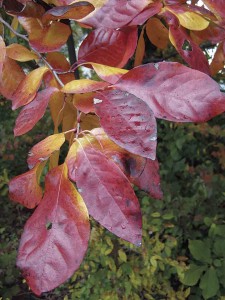
A brilliant red

Photo by Ken Moore. Each brilliant red leaf of black gum appears polished.
Ken Moore
I eagerly anticipate the fall coloring of black gum, Nyssa sylvatica. Because the bright red leaves are among the most brilliant of fall colors, it is a favorite American tree planted in English gardens.
Though it is a regular component of our deciduous forests, it’s seldom seen as a standout specimen unless it happens to be exposed along a roadside forest edge. Most frequently, it will capture your attention when just a branch or two of those shiny, eye-catching red leaves reach out from an otherwise green-leaved background.
During a woods walk at this time of year, if you notice the ground strewn with numerous small egg-shaped, black, berry-like fruits, look up and you will discover yourself beneath a mature black gum. Those fleshy drupes are a tasty treat for birds and other wild critters.
North Carolina Lumbee and Cherokee herbal literature includes descriptions of numerous decoctions of the root and stem bark for medicinal purposes. A particularly interesting use is described in Herbal Remedies of the Nyssa sylvatica Indians by Boughman and Oxendine: “Many Lumbee families would cut Black Gum branches to serve as a toothbrush. They would strip the bark from a section of a small branch.
The end of this branch was then chewed until the end was compressed or ragged like toothbrush bristles. With the flattened end, the gum and teeth were massaged. This stick was sometimes left in the mouth for an hour for chewing and occasional rubbing.â€
In Paul Green’s Plant Book, a little more is added: “The little limb sprouts from the small trees made good toothbrushes – nearly all the snuff-dippers used them.â€
That really takes me back to happy days spending summers on my aunt’s Warren County farm. I was always so happy when she would accompany me into the woods because it was time to gather gum twigs for my grandmother’s snuff brushes. I really enjoyed chewing those twigs into brushes; the recollection of one dip into that snuff, however, has lasted me to this day!
The wood is so tough that lumberman left it alone, too tough even to chop into firewood. The old trees were often hollow and provided good places for bee hives. Green relates how he and his buddies used the tree: “We used to cut down a good-sized tree and saw off narrow sections to make wheels for our play wagons.â€
Back then youngsters played in the fields and forests, where they learned valuable lessons from gums and other trees while having fun.
Native black gums are now showing up in local nurseries because they are fine ornamental shade trees for fall planting.
Now that we are having serious frosty spells, you’ll notice more rapid coloring of our forests. Some of the black gums (you know to distinguish them from the star-leafed sweet gums, Liquidambar styraflua) have already become bare of foliage, while others are still green except for perhaps that odd red branch or two. Remember to watch the forest borders for those polished shiny brilliant red leaves during this whole next week.
from → Fall, Ken Moore's Flora

Comments are closed.